key Alfa Romeo GT 2010 Owner handbook (in English)
[x] Cancel search | Manufacturer: ALFA ROMEO, Model Year: 2010, Model line: GT, Model: Alfa Romeo GT 2010Pages: 271, PDF Size: 5.34 MB
Page 131 of 271

GETTING TO KNOW YOUR CAR
129fig. 143
A0A0637b
fig. 144
A0A0658b
Closing the tailgate again, the control func-
tions are restored, the system “beeps” twice
(with the exception of certain markets).
TAILGATE CLOSING
To lock, push in correspondence with the
Alfa Romeo badge to lower tailgate, until
you feel the click of the lock.
BOOT LIGHT (fig. 143)
When the tailgate is opened the light turns
on automatically (A) in the right-hand side
of the boot. Closing the tailgate, the light
turns off automatically.
IMPORTANTTurning the ignition key to
STOP, opening the tailgate, turning on the
light will only be possible for 15 minutes;
after which the system turns it off to avoid
draining the battery. EMERGENCY OPENING
OF TAILGATE
To succeed in opening the tailgate from the
inside, should the car battery be flat, or be-
cause of a defect of the electric lock of the
tailgate itself, proceed as follows (see “Ex-
tending the luggage compartment” in the
chapter “Getting to know you car”):
– tilt the rear seat cushions;
– tilt the backrests;
– unlock the lock by pulling the string (A-
fig. 144) (the string is located inside the
right recess in the tailgate).
Page 133 of 271
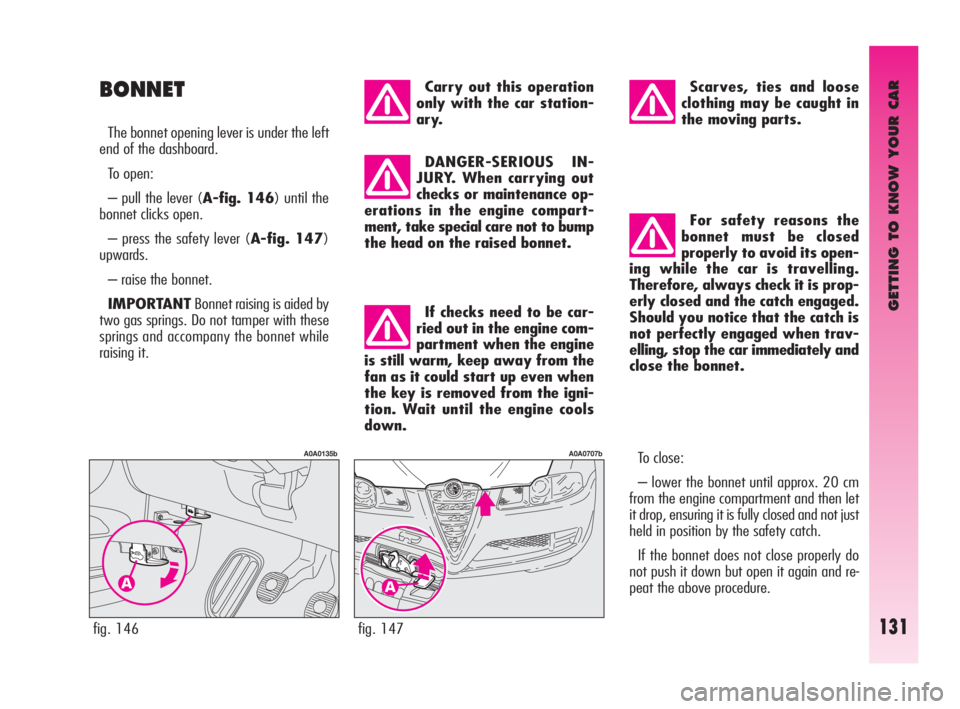
GETTING TO KNOW YOUR CAR
131fig. 147
A0A0707b
Carry out this operation
only with the car station-
ary.
DANGER-SERIOUS IN-
JURY. When carrying out
checks or maintenance op-
erations in the engine compart-
ment, take special care not to bump
the head on the raised bonnet.
If checks need to be car-
ried out in the engine com-
partment when the engine
is still warm, keep away from the
fan as it could start up even when
the key is removed from the igni-
tion. Wait until the engine cools
down.
BONNET
The bonnet opening lever is under the left
end of the dashboard.
To open:
– pull the lever (A-fig. 146) until the
bonnet clicks open.
– press the safety lever (A-fig. 147)
upwards.
– raise the bonnet.
IMPORTANTBonnet raising is aided by
two gas springs. Do not tamper with these
springs and accompany the bonnet while
raising it.
fig. 146
A0A0135b
Scarves, ties and loose
clothing may be caught in
the moving parts.
For safety reasons the
bonnet must be closed
properly to avoid its open-
ing while the car is travelling.
Therefore, always check it is prop-
erly closed and the catch engaged.
Should you notice that the catch is
not perfectly engaged when trav-
elling, stop the car immediately and
close the bonnet.
To close:
– lower the bonnet until approx. 20 cm
from the engine compartment and then let
it drop, ensuring it is fully closed and not just
held in position by the safety catch.
If the bonnet does not close properly do
not push it down but open it again and re-
peat the above procedure.
Page 142 of 271

GETTING TO KNOW YOUR CAR
140
EOBD SYSTEM
(upon request for versions/
markets where applicable)
The EOBD system (European On Board Di-
agnosis) allows continuous diagnosis of the
components of the car correlated with emis-
sions.
It also alerts the driver, by turning on the
warning light
Uon the instrument panel
(on certain versions together with message
+ symbol on the reconfigurable multifunc-
tion display), when these components are
no longer in peak conditions.
The objective is:
– to keep the system efficiency under con-
trol;
– to warn when a fault causes emissions
levels to increase;
– to warn of the need to replace deterio-
rated components.The system also has a diagnostic connec-
tor that can be interfaced with appropriate
tools, which makes it possible to read the
error codes stored in the control unit, to-
gether with a series of specific parameters
for engine operation and diagnosis. This
check can also be carried out by the traffic
police.IMPORTANTAfter eliminating the in-
convenience, to check the system com-
pletely, Alfa Romeo Authorised Services are
obliged to run a bench test and, if necessary,
road tests which may also call for a long jour-
ney.
If, turning the ignition key
to MAR, the warning light
Udoes not turn on or if,
while travelling it turns on glow-
ing steadily or flashing (on some
versions together with the mes-
sage + symbol on the reconfig-
urable multifunction display), con-
tact Alfa Romeo Authorised Ser-
vices as soon as possible.
Page 152 of 271

GETTING TO KNOW YOUR CAR
150
Selecting CD/CD Changer
functions
Pressing briefly and repeatedly button CD
it is possible to select the following audio
sources in sequence:
– CD (only if the Compact Disc is insert-
ed);
– CHANGER (only if the CD Changer is con-
nected).
Audio source memory function
If while listening to a CD another function
is selected (e.g.: the radio), playing is
stopped and when the CD mode is resumed,
it starts again from the point in which it was
stopped.
If while listening to the radio another func-
tion is selected, when the Radio mode is
resumed, it is tuned to the last station se-
lected.Volume adjustment
Adjust volume through VOL + and VOL -
buttons.
If the volume level is changed during the
broadcast of a traffic bulletin, the new set-
ting is maintained only until the end of the
bulletin.
SVC function
(excluding versions with
Bose HI-FI system)
The SVC function makes it possible to au-
tomatically adapt the volume level to the
speed of the car, increasing it as the speed
increases to maintain the ratio with the noise
level inside the passenger compartment.
See section MENU for activating/deacti-
vating this function. FUNCTIONS AND
ADJUSTMENTS
Turning the sound system on The set is
switched on pressing button ON.
When turning the sound system on, the
volume level will be brought to 20 if it was
set to over.
If the radio is turned on when the key is
not fitted into the ignition device, it will turn
off automatically after about 20 minutes.
After automatic switching off, it is however
possible to turn the radio on again for oth-
er 20 minutes by pressing button ON (see
paragraph “IGN TIME function”).
Turning the sound system off
Keep button ON pressed.
Selecting radio functions
Pressing briefly and repeatedly button
FM
ASit is possible to select the following
functions in sequence:
– TUNER (“FM1”, “FM2”, “FMT”);
Pressing briefly and repeatedly button AM
it is possible to select the following functions
in sequence:
– TUNER (“MW”, “LW”).
Page 160 of 271

GETTING TO KNOW YOUR CAR
158
EXT function
(external audio source control)
With this function it is possible to adjust
(setting from 0 to 40) or exclude (OFF) ex-
ternal audio sources.
To turn this function on/off, use button
÷or˜.
The display will show the current status
of the function:
– “EXT VOL”: function on.
– “EXT OFF”: function off.
– “EXT 23”: function on with volume lev-
el 23.
IGN TIME function
(system power on/off mode radio)
This function enables to switch off the
sound system according to two different
modes. To turn the function on use button
÷or˜.
The display will show “IGN TIME” and then:
– “00 MIN”: deactivation dependent on
ignition key. Sound system will switch off
automatically when turning the ignition key
to STOP;
– “20 MIN”: deactivation independent of
ignition key. After having turned the ignition
key to STOP the sound system will stay on
for 20 minutes max.IMPORTANTWhen the sound system
is switched off automatically after turning
the ignition key to STOP (for both immedi-
ate or 20-minute delayed power off), it will
switch on automatically turning the ignition
key to MAR. If the sound system has been
switched off pressing button ON, when turn-
ing the key to MAR it will stay off.
RESTORE function
This function enables to restore default set-
tings. Options available are the following:
– NO: no restore;
– YES: restore default settings. During this
operation the display will show the message
“RESTORE”. At the end of this operation,
the audio source will not be changed and
the previous situation is displayed. SVC function
(volume changing with speed)
(excluding versions with
Bose HI-FI system)
This function makes it possible to auto-
matically adapt the volume level to the
speed of the car, increasing it as the speed
increases to maintain the ratio with the noise
level inside the passenger compartment.
To turn the function on/off use button
÷or˜. The display will show the cur-
rent status of the function:
– SVC OFF: function off
– SVC LOW: function on
(low sensitivity)
– SVC HIGH: function on
(high sensitivity).
Page 163 of 271

GETTING TO KNOW YOUR CAR
161
Entering the secret code
When turning the sound system on (in the
event of code request), the display will show
the word “CDC CODE” for about 2 seconds,
followed by four dashes “- - - -”.
The secret code comprises four figures from
1 to 6, each corresponding to one of the
dashes.
To enter the first digit of the code, press
the corresponding key of the preset stations
(from 1 to 6). Enter the other code digits in
the same way.
If the four figures are not entered within
20 seconds, the display shows the word
“CDC CODE” for 2 seconds and then fours
dashes “- - - -”. This is not to be considered
as an incorrect code entry.
After entering the fourth digit (within 20
seconds), the radio starts working.
If a wrong code is entered, the radio
sounds a beep, the display shows the word
“CDC CODE” for 2 seconds and then fours
dashes “- - - -” to warn the user that it is nec-
essary to enter the correct code. Every time the user enters a wrong code,
the waiting time increases gradually (1 min,
2 min, 4 min, 8 min, 16 min, 30 min,1h,
2h, 4h, 8h, 16h, 24h) until reaching a max-
imum of 24 hours. The waiting time will
be shown on the display with the word “CDC
WAIT”. When this goes off it is possible to
start the new code entry procedure.
Code Card
This the document that certifies possession
of the radio. The Code Card contains the ra-
dio model, serial number and secret code.
IMPORTANTKeep the Code Card care-
fully to be able to give the related data to
the competent authorities in the event of
theft. Antitheft protection
The radio is fitted with an antitheft pro-
tection system based on the exchange of in-
formation between the radio and the elec-
tronic control unit (Body Computer) installed
on the car.
This system warrants the highest level of
security and prevents entry of the secret
code every time the radio supply is discon-
nected.
If the result of the check is positive, the set
starts working, whereas if the comparison
codes are not the same or if the electronic
control unit (Body Computer) is replaced,
the device informs the user of the need to
enter the secret code according to the pro-
cedure described in the following paragraph.
Page 171 of 271
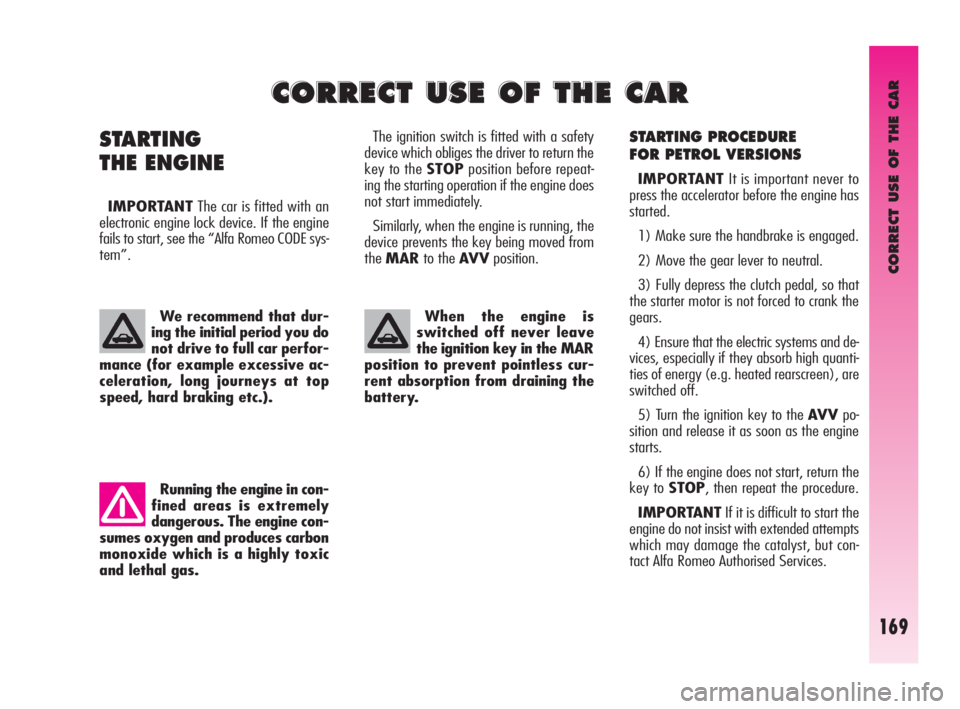
CORRECT USE OF THE CAR
169
STARTING PROCEDURE
FOR PETROL VERSIONS
IMPORTANTIt is important never to
press the accelerator before the engine has
started.
1) Make sure the handbrake is engaged.
2) Move the gear lever to neutral.
3) Fully depress the clutch pedal, so that
the starter motor is not forced to crank the
gears.
4) Ensure that the electric systems and de-
vices, especially if they absorb high quanti-
ties of energy (e.g. heated rearscreen), are
switched off.
5) Turn the ignition key to the AV Vpo-
sition and release it as soon as the engine
starts.
6) If the engine does not start, return the
key to STOP, then repeat the procedure.
IMPORTANTIf it is difficult to start the
engine do not insist with extended attempts
which may damage the catalyst, but con-
tact Alfa Romeo Authorised Services. The ignition switch is fitted with a safety
device which obliges the driver to return the
key to the STOPposition before repeat-
ing the starting operation if the engine does
not start immediately.
Similarly, when the engine is running, the
device prevents the key being moved from
theMARto the AV Vposition.
STARTING
THE ENGINE
IMPORTANTThe car is fitted with an
electronic engine lock device. If the engine
fails to start, see the “Alfa Romeo CODE sys-
tem”.
C C
O O
R R
R R
E E
C C
T T
U U
S S
E E
O O
F F
T T
H H
E E
C C
A A
R R
We recommend that dur-
ing the initial period you do
not drive to full car perfor-
mance (for example excessive ac-
celeration, long journeys at top
speed, hard braking etc.).
Running the engine in con-
fined areas is extremely
dangerous. The engine con-
sumes oxygen and produces carbon
monoxide which is a highly toxic
and lethal gas.
When the engine is
switched off never leave
the ignition key in the MAR
position to prevent pointless cur-
rent absorption from draining the
battery.
Page 172 of 271
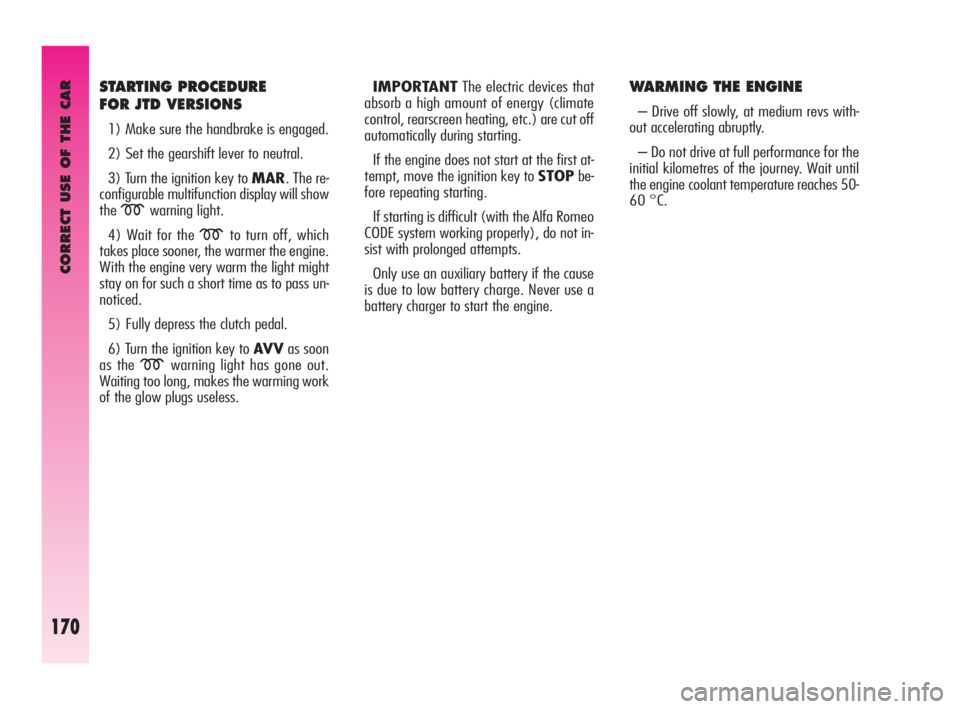
CORRECT USE OF THE CAR
170
STARTING PROCEDURE
FOR JTD VERSIONS
1) Make sure the handbrake is engaged.
2) Set the gearshift lever to neutral.
3) Turn the ignition key to MAR. The re-
configurable multifunction display will show
the
mwarning light.
4) Wait for the
mto turn off, which
takes place sooner, the warmer the engine.
With the engine very warm the light might
stay on for such a short time as to pass un-
noticed.
5) Fully depress the clutch pedal.
6) Turn the ignition key to AV Vas soon
as the
mwarning light has gone out.
Waiting too long, makes the warming work
of the glow plugs useless.IMPORTANTThe electric devices that
absorb a high amount of energy (climate
control, rearscreen heating, etc.) are cut off
automatically during starting.
If the engine does not start at the first at-
tempt, move the ignition key to STOPbe-
fore repeating starting.
If starting is difficult (with the Alfa Romeo
CODE system working properly), do not in-
sist with prolonged attempts.
Only use an auxiliary battery if the cause
is due to low battery charge. Never use a
battery charger to start the engine.
WARMING THE ENGINE
– Drive off slowly, at medium revs with-
out accelerating abruptly.
– Do not drive at full performance for the
initial kilometres of the journey. Wait until
the engine coolant temperature reaches 50-
60 °C.
Page 173 of 271
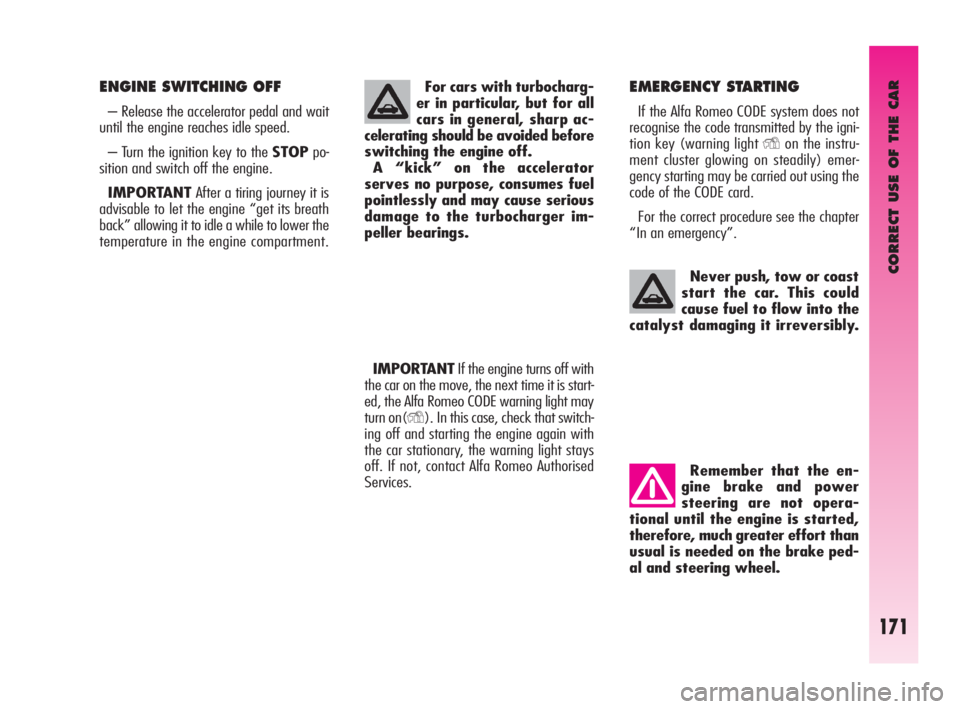
CORRECT USE OF THE CAR
171
Never push, tow or coast
start the car. This could
cause fuel to flow into the
catalyst damaging it irreversibly.
Remember that the en-
gine brake and power
steering are not opera-
tional until the engine is started,
therefore, much greater effort than
usual is needed on the brake ped-
al and steering wheel. For cars with turbocharg-
er in particular, but for all
cars in general, sharp ac-
celerating should be avoided before
switching the engine off.
A “kick” on the accelerator
serves no purpose, consumes fuel
pointlessly and may cause serious
damage to the turbocharger im-
peller bearings.
EMERGENCY STARTING
If the Alfa Romeo CODE system does not
recognise the code transmitted by the igni-
tion key (warning light
Yon the instru-
ment cluster glowing on steadily) emer-
gency starting may be carried out using the
code of the CODE card.
For the correct procedure see the chapter
“In an emergency”.
IMPORTANTIf the engine turns off with
the car on the move, the next time it is start-
ed, the Alfa Romeo CODE warning light may
turn on(
Y). In this case, check that switch-
ing off and starting the engine again with
the car stationary, the warning light stays
off. If not, contact Alfa Romeo Authorised
Services.
ENGINE SWITCHING OFF
– Release the accelerator pedal and wait
until the engine reaches idle speed.
– Turn the ignition key to the STOPpo-
sition and switch off the engine.
IMPORTANTAfter a tiring journey it is
advisable to let the engine “get its breath
back” allowing it to idle a while to lower the
temperature in the engine compartment.
Page 174 of 271
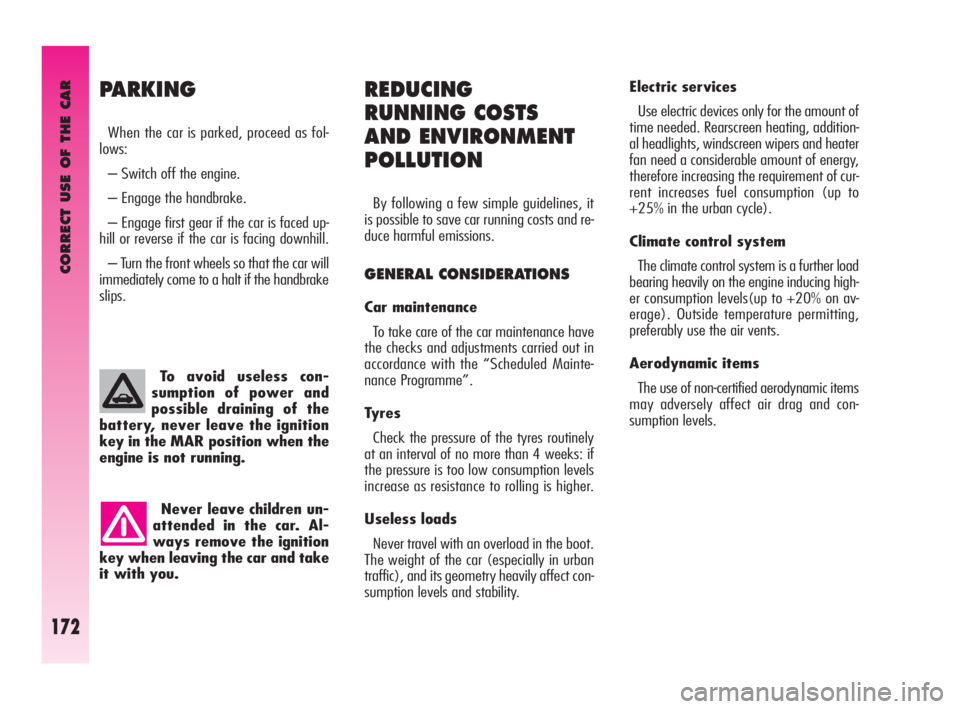
CORRECT USE OF THE CAR
172
Never leave children un-
attended in the car. Al-
ways remove the ignition
key when leaving the car and take
it with you.To avoid useless con-
sumption of power and
possible draining of the
battery, never leave the ignition
key in the MAR position when the
engine is not running.
PARKING
When the car is parked, proceed as fol-
lows:
– Switch off the engine.
– Engage the handbrake.
– Engage first gear if the car is faced up-
hill or reverse if the car is facing downhill.
– Turn the front wheels so that the car will
immediately come to a halt if the handbrake
slips.
REDUCING
RUNNING COSTS
AND ENVIRONMENT
POLLUTION
By following a few simple guidelines, it
is possible to save car running costs and re-
duce harmful emissions.
GENERAL CONSIDERATIONS
Car maintenance
To take care of the car maintenance have
the checks and adjustments carried out in
accordance with the “Scheduled Mainte-
nance Programme”.
Tyres
Check the pressure of the tyres routinely
at an interval of no more than 4 weeks: if
the pressure is too low consumption levels
increase as resistance to rolling is higher.
Useless loads
Never travel with an overload in the boot.
The weight of the car (especially in urban
traffic), and its geometry heavily affect con-
sumption levels and stability.Electric services
Use electric devices only for the amount of
time needed. Rearscreen heating, addition-
al headlights, windscreen wipers and heater
fan need a considerable amount of energy,
therefore increasing the requirement of cur-
rent increases fuel consumption (up to
+25% in the urban cycle).
Climate control system
The climate control system is a further load
bearing heavily on the engine inducing high-
er consumption levels(up to +20% on av-
erage). Outside temperature permitting,
preferably use the air vents.
Aerodynamic items
The use of non-certified aerodynamic items
may adversely affect air drag and con-
sumption levels.